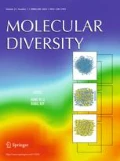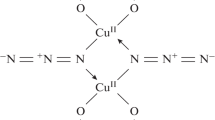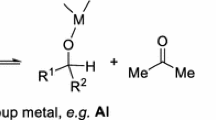Abstract
A hydrogen autotransfer reaction has been applied to the α-alkylation of ketones, with primary alcohols as the electrophilic component, either under homogeneous (using a Ru complex as catalyst) or under heterogeneous (using Ni nanoparticles) conditions. This process is both very efficient (concerning atom economy) and ecologically friendly (water as the only by-product generated). On the other hand, three multicomponent reactions, namely, the Strecker reaction (without any catalyst), the aza-Sakurai process (catalyzed by ferrite), and the addition of in situ generated Zn enolates to chiral sulfinylimines (catalyzed by Cu), have proven to be very efficient in the generation of a diversity of polyfunctionalized molecules.
Similar content being viewed by others
References
Pimentel GC (1985) Opportunities in chemistry. Committee to survey opportunities in the chemical science. National Academy of Science of USA. Available via http://www.nap.edu/openbook.php?record_id=606&page=R1. Accessed 8 Jun 2009
European Commission CORDIS. Available via http://cordis.europa.eu/fp7/. Accessed 8 Jun 2009
Sheldon RA (2008) E factors, green chemistry and catalysis: an odyssey. Chem Commun 3352–3365. doi:10.1039/b803584a
Gall M, House HO (1988) The formation and alkylation of specific enolate anions from an unsymmetrical ketone: 2-benzyl-2-methylcyclohexanone and 2-benzyl-6-methylcyclohexanone. Org Synth Coll 6: 121–130
Negishi E-I, Idacavage MJ, DiPasquale F, Silveira A (1979) A highly selective method for α-alkylation of ketones via potassium enoxytrialkylborates. Tetrahedron Lett 20: 845–848. doi:10.1016/S0040-4039(01)93567-1
Stork G, Brizzolara A, Landesman H, Szmuszkovicz J, Terrell R (1963) The enamine alkylation and acylation of carbonyl compounds. J Am Chem Soc 85: 207–222. doi:10.1021/ja00885a021
Cainelli GF, Panunzio M, Umani-Ronchi A (1975) Chemistry of alkali metal tetracarbonylferrates. A simple method for alkylating and arylating carbonyl compounds and active methylene compounds. J Chem Soc Perkin Trans 1: 1273–1275. doi:10.1039/P19750001273
Guerbet M (1901) Action of normal propyl and butyl alcohols on their respective sodium derivatives: synthesis of dipropyl and dibutyl alcohols. C R Hebd Seances Acad Sci 133: 1220–1222
Chabardes P, Querou Y (1969) Alkylation of ketones. French patent assignee to Rhone-Poulenc SA. FR1582621. [(1970) Chem Abstr 73:61760]
Guillena G, Ramón DJ, Yus M (2007) Alcohols as electrophiles in C–C bond-forming reactions: the hydrogen autotransfer process. Angew Chem Int Ed 46: 2358–2364. doi:10.1002/anie.200603794
Martínez R, Ramón DJ, Yus M (2006) Easy α-alkylation of ketones with alcohols through a hydrogen autotransfer process catalyzed by RuCl2(DMSO)4. Tetrahedron 62: 8988–9001. doi:10.1016/j.tet.2006.07.013
Martínez R, Brand GJ, Ramón DJ, Yus M (2005) [Ru(DMSO)4]Cl2 catalyzes the α-alkylation of of ketones by alcohols. Tetrahedron Lett 46: 3683–3686. doi:10.1016/j.tetlet.2005.03.158
Martínez R, Ramón DJ, Yus M (2006) RuCl2(DMSO)4 catalyzes the β-alkylation of secondary alcohols with primary alcohols through a hydrogen autotransfer process. Tetrahedron 62: 8982–8987. doi:10.1016/j.tet.2006.07.012
Martínez R, Ramón DJ, Yus M (2007) RuCl2(DMSO)4 catalyzes the solvent-free indirect Friedländer synthesis of polysubstituted quinolines from alcohols. Eur J Org Chem 1599–1605. doi:10.1002/ejoc.200600945
Martínez R, Ramón DJ, Yus M (2008) Transition-metal-free indirect Friedländer synthesis of quinolines from alcohols. J Org Chem 73: 9778–9780. doi:10.1021/jo801678n
Martínez R, Zoli L, Cozzi PG, Ramón DJ, Yus M. (2008) Synthesis of camphorsulfonamide-based quinoline ligands and their N-oxides: first use in the enantioselective addition of organozinc reagents to aldehydes. Tetrahedron: Asymmetry 19: 2600–2607. doi:10.1016/j.tetasy.2008.10.020
Kotani M, Koike T, Yamaguchi K, Mizuno N (2006) Ruthenium hydroxide on magnetite as magnetically separable heterogeneous catalyst for liquid-phase oxidation and reduction. Green Chem 8: 735–741. doi:10.1039/b603204d
Martínez R (2009) Reacciones de autotransferencia de hidrógeno y multicomponente de hidrógeno catalizadas por RuCl2 (DMSO)4y Fe3O4. Dissertation, University of Alicante
Martínez R, Ramón DJ, Yus M (2009) Selective N-monoalkylation of aromatic amines with benzylic alcohols by a hydrogen autotransfer process catalyzed by unmodified magnetite. Org Biomol Chem 7: 2176–2181. doi:10.1039/b901929d
Alonso F, Radivoy G, Yus M (2003) Active-nickel based reduction of organic compounds. Russ Chem Bull Int Ed 52: 2563–2576. doi:1066-5285/03/5212-2628
Alonso F, Yus M (2004) The NiCl2-Li-arene(cat.) combination: a versatile reducing mixture. Chem Soc Rev 33: 284–293. doi:10.1039/b315131j
Alonso F, Yus M (2008) New synthetic methodologies based on active transition metals. Pure Appl Chem 80: 1005–1012. doi:10.1351/pac200880051005
Alonso F, Calvino JJ, Osante I, Yus M (2005) A new straightforward and mild preparation of nickel(0) nanoparticles. Chem Lett 34: 1262–1263. doi:10.1246/cl.2005.1262
Alonso F, Calvino JJ, Osante I, Yus M (2006) Preparation of nickel(0) nanoparticles by arene-catalyzed reduction of different nickel chloride-containing systems. J Exp Nanosci 1: 419–433. doi:10.1080/17458080601027652
Alonso F, Osante I, Yus M (2006) Highly stereoselective semihydrogenation of alkynes promoted by nickel(0) nanoparticles. Adv Synth Catal 348: 305–308. doi:10.1002/adsc.200505327
Alonso F, Osante I, Yus M (2007) Highly selective hydrogenation of multiple carbon-carbon bonds promoted by nickel(0) nanoparticles. Tetrahedron 63: 93–102. doi:10.1016/j.tet.2006.10.043
Alonso F, Osante I, Yus M (2006) Conjugate reduction of α, β-unsaturated carbonyl compounds promoted by nickel nanoparticles. Synlett 3017–3020. doi:10.1055/s-2006-951494
Alonso F, Riente P, Yus M (2008) Hydrogen transfer reduction of carbonyl compounds promoted by nickel(0) nanoparticles. Tetrahedron 64: 1847–1852. doi:10.1016/j.tet.2007.11.093
Alonso F, Riente P, Yus M (2008) Hydrogen transfer reduction of carbonyl compounds catalysed by nickel nanoparticles. Tetrahedron Lett 49: 1939–1942. doi:10.1016/j.tet.2007.12.036
Alonso F, Riente P, Yus M (2007) The α-alkylation of methyl ketones with primary alcohols promoted by nickel nanoparticles under mild and ligandless conditions. Synlett 1877–1880. doi:10.1055/s-2007-984522
Alonso F, Riente P, Yus M (2008) Alcohols for the α-alkylation of methyl ketones and indirect aza-Wittig reaction promoted by nickel nanoparticles. Eur J Org Chem 4908–4914 doi:10.1002/ejoc.200800729
Palacios F, Alonso C, Aparicio D, Rubiales G, de los Santos JM (2007) The aza-Wittig reacion: an efficient tool for the construction of carbon-nitrogen double bonds. Tetrahedron 63: 523–575. doi:10.1016/j.tet.2006.09.048
Cami-Kobeci G, Williams JMJ (2004) Conversion of alcohols into N-alkyl anilines via an indirect aza-Wittig reaction. Chem Commun 1072–1073. doi:10.1039/b402020k
Taylor RJK, Reid M, Foot J, Raw SA (2005) Tandem oxidation processes using manganese dioxide: discovery, applications, and current studies. Acc Chem Res 38: 851–869. doi:10.1021/ar050113t
Alonso F, Riente P, Yus M (2009) One-pot synthesis of stilbenes from alcohols through a Wittig-type olefination reaction promoted by nickel nanoparticles. Synlett 1579–1582. doi:10.1055/s-0029-1217333
Zhu J, Bienaymé H (eds) (2005) Multicomponent reactions. Wiley-VCH, Weinheim
Ramón DJ, Yus M (2005) Asymmetric multicomponent reactions (AMCRs): the new frontier. Angew Chem Int Ed 44: 1602–1634. doi:10.1002/anie.200460548
Guillena G, Ramón DJ, Yus M (2007) Organocatalytic enantioselective multicomponent reactions (OEMCRs). Tetrahedron: Asymmetry 18: 693–700. doi:10.1016/j.tetasy.2007.03.002
Merino P, Marqués-López E, Tejero T, Herrera RP (2009) Organocatalyzed Strecker reactions. Tetrahedron 65: 1219–1234. doi:10.1016/j.tet.2008.11.020 (and references therein)
Gawronski J, Wascinska N, Gajewy J (2008) Recent progress in Lewis base activation and control of sterereoselectivity in the addition of trimethylsilyl nucleophiles. Chem Rev 108: 5227–5242. doi:10.1021/cr800421c
Martínez R, Ramón DJ, Yus M (2005) Catalyst-free multicomponent Strecker reaction in acetonitrile. Tetrahedron Lett 46: 8471–8474. doi:10.1016/j.tetlet.2005.10.020
Martínez R, Ramón DJ, Yus M (2008) Unmodified nano-powder magnetite catalyzes a four-component aza-Sakurai reaction. Adv Synth Catal 350: 1235–1240. doi:10.1002/adsc.200800089
Feringa BL (2000) Phosphoramidites: marvellous ligands in catalytic asymmetric conjugate addition. Acc Chem Res 33: 346–353. doi:10.1021/ar990084k
Alexakis A, Benhaim C (2002) Enantioselective copper-catalysed conjugate addition. Eur J Org Chem 3221–3236. doi:10.1002/1099-0690(200210)2002:19<3221:AID-EJOC3221>3.0.CO;2-U
Kitamura M, Miki T, Nakano K, Noyori R (1996) Conjugate addition of diorganozincs to α, β-unsaturated ketones catalyzed by a copper(I)-sulfonamide combined system. Tetrahedron Lett 37: 5141–5144. doi:10.1016/0040-4039(96)01038-6
Feringa BL, Pineschi M, Arnold LA, Imbos R, de Vries AHM (1997) Highly enantioselective catalytic conjugate addition and tandem conjugate addition-aldol reactions of organozinc reagents. Angew Chem Int Ed 36: 2620–2623. doi:10.1002/anie.199726201
González-Gómez JC, Foubelo F, Yus M (2008) Tandem enantioselective conjugate addition-Mannich reactions: efficient multicomponent assembly of dialkylzincs, cyclic enones and chiral N-sulfinimines. Tetrahedron Lett 49: 2343–2347. doi:10.1016/j.tetlet.2008.02.076
González-Gómez JC, Foubelo F, Yus M (2009) Modular stereocontrolled assembly of R2Zn, cyclic enones and N-tert-butanesulfinyl imines. J Org Chem 74: 2547–2553. doi:10.1021/jo802812w
González-Gómez JC, Foubelo F, Yus M (2009) Stereocontrolled synthesis of 1,3-amino alcohols by reduction of subtituted 2-{1-[(tert-butylsulfinyl)amino]alkyl}cyclohexanones. Synthesis 2083–2088 doi:10.1055/s-0029-1216821
Author information
Authors and Affiliations
Corresponding author
Additional information
This account is based on a lecture delivered by one of the authors (M.Y.) at the IV International Conference on ‘Multi-Component Reactions and Related Chemistry’, Ekaterinburg (Russia), May 24–28.
Rights and permissions
About this article
Cite this article
Alonso, F., Foubelo, F., González-Gómez, J.C. et al. Efficiency in chemistry: from hydrogen autotransfer to multicomponent catalysis. Mol Divers 14, 411–424 (2010). https://doi.org/10.1007/s11030-009-9195-z
Received:
Accepted:
Published:
Issue Date:
DOI: https://doi.org/10.1007/s11030-009-9195-z




